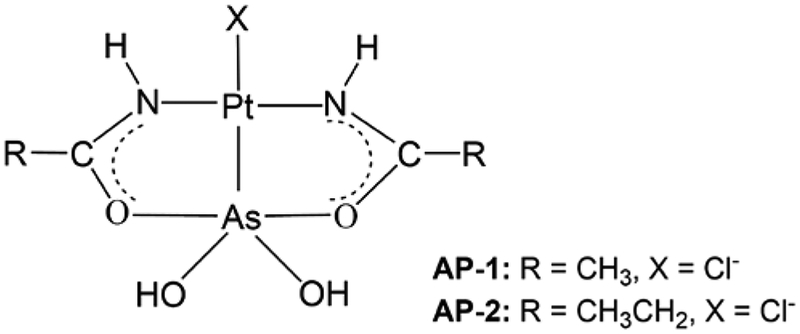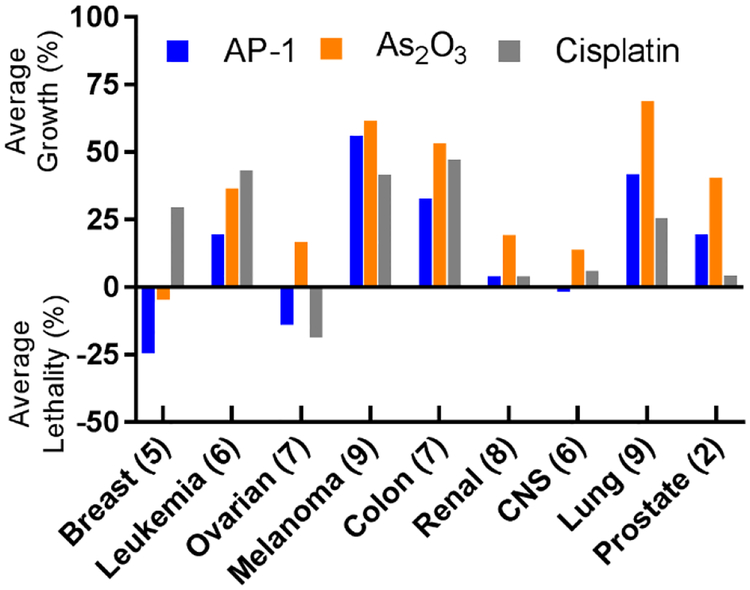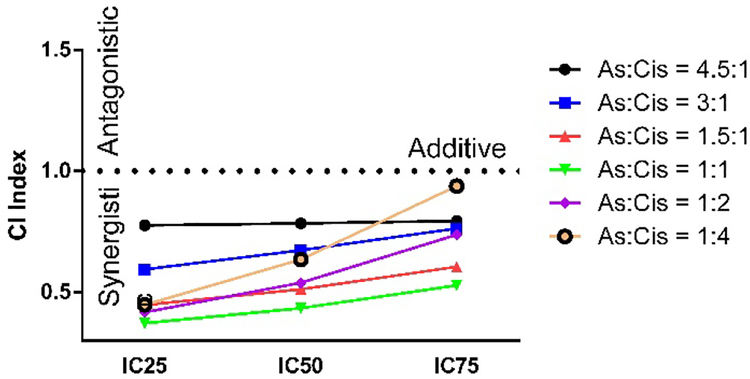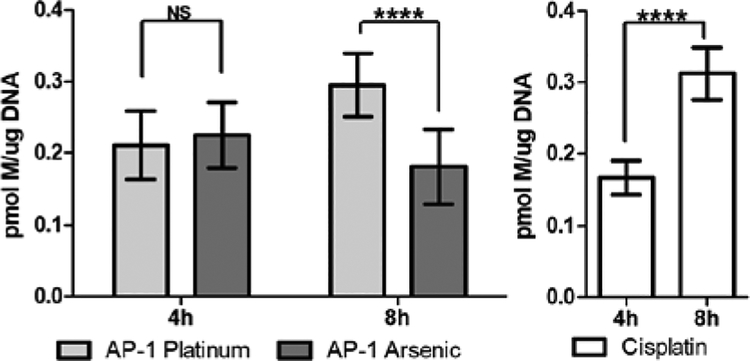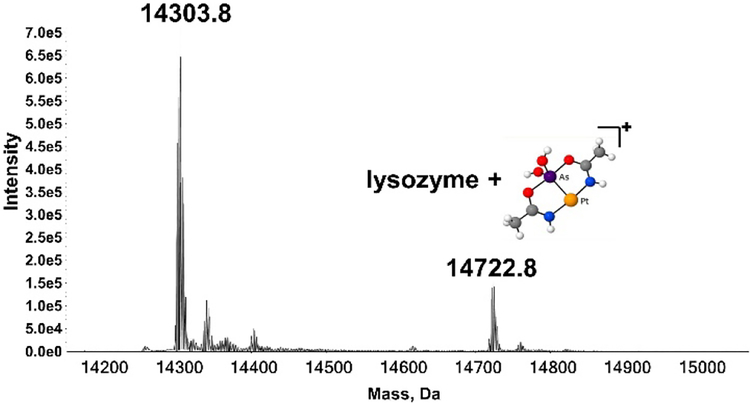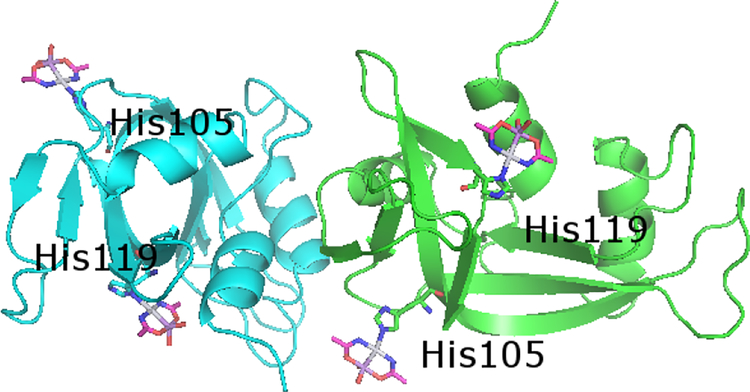Abstract
Arsenoplatins are adducts of two chemically important anticancer drugs, cisplatin and arsenic trioxide, that have a Pt(II) bond to an As(III) hydroxide center. Screens of the NCI-60 human tumor cell lines reveal that arsenoplatin-1 (AP1), [Pt(μ-NHC(CH3)O)2ClAs(OH)2], the first representative of this novel class of anti-cancer agents, displays a superior activity profile relative to the parent drugs As2O3 or cisplatin in majority of cancer cell lines tested. These activity profiles are important because the success of arsenic trioxide in blood cancers (such as APL) has not been seen in solid tumors due to the rapid clearance of arsenous acid from the body. To understand the biological chemistry of these compounds, we evaluated interactions of AP-1 with the two important classes of biomolecules – proteins and DNA. The first structural studies of AP-1 bound to model proteins reveal that platinum(II) binds the Nε of His in a manner that preserves the Pt-As bond. We find that AP-1 readily enters cells and binds to DNA with an intact Pt-As bond (Pt:As ratio of 1). At longer incubation times, however, the Pt:As ratio in DNA samples increases, suggesting that the Pt-As bond breaks and releases the As(OH)2 moiety. We conclude that arsenoplatin-1 has the potential to deliver both Pt and As species to a variety of hematological and solid cancers.
Graphical Abstract
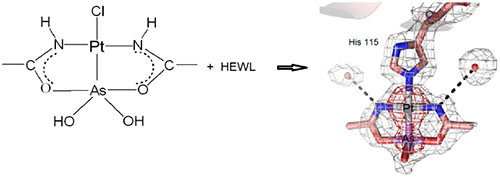
The serendipitous discovery of cisplatin more than 50 years ago1 and its consequent approval in 1978 marked the beginning of the use of FDA-approved metal complexes as anti-cancer drugs. Cisplatin and its analogues continue to be widely used as single agents or especially in combination with other drugs. For instance, cisplatin is a component in more active clinical trials worldwide than any other anticancer agent2. Unfortunately, intrinsic and acquired resistance due to mutations remain as major obstacles for the use of platinum drugs in treating cancer3–5. Accordingly, many new types of platinum compounds have been designed to overcome platinum resistance: trans-Pt(II)-compounds6, polynuclear Pt(II)-compounds7, Pt(IV) prodrugs8–9, Pt(IV)-prodrugs activated by visible light10, glucose-platinum conjugates,11–12 as well as new drug delivery systems are being evaluated.13–14 Cisplatin, carboplatin, oxaliplatin, and arsenic trioxide (As2O3)15–17 are only non-radioactive metal/metalloid containing drugs approved by the FDA to treat cancer. These drugs are able to trigger apoptotic cell death; in the case of platinum compounds through direct platinum binding to nuclear DNA18–19, and in the case of As2O3 most likely through the thiophilic As(III) binding to cysteine rich proteins and by its ability to displace zinc from zinc finger containing regulatory proteins.20–22
The identification of a novel Pt-As bond in a nanoparticulate delivery system loaded with arsenic trioxide and cisplatin in our lab13 spurred the development of arsenoplatins (Chart 1).23 These complexes can be synthesized directly from reaction of arsenic trioxide with cisplatin in a suitable solvent mixture. Arsenoplatins in their structure possess an arsenous acid moiety covalently linked to platinum(II) center with an unusual five coordinate As(III)-geometry. The presence of the coordinated As(III) distinguishes the reactivity of AP-1 from cisplatin reactivity. The substitution of Cl− with small ligands such as SCN− in an aqueous solution is rapid at room temperature due to a very strong trans effect of the arsenic atom.23 We show here that substitution of Cl− in AP-1 by DMSO does not occur in neat DMSO (Figure S1 and Table S1).
Chart 1.
AP-1 is stable in phosphate buffer saline, saline, DMSO, and methanol solutions for over 48 hours (Figures S1 and S2). 195Pt NMR studies of AP-1 dissolved in DMSO23 or methanol reveal that the Pt-Cl bond remains intact in both solvents (Figure S3 and Table S1). Unlike cisplatin, which is prone to solvolysis in DMSO solution at longer times24 AP-1, oxaliplatin, and carboplatin are stable in neat DMSO25.
Preliminary in vitro cytotoxicity evaluation suggested that arsenoplatins may have a distinct mode of action in comparison to cisplatin and As2O3, as well as the ability to overcome platinum resistance mechanisms.23 To investigate the breadth of anti-cancer activity of this new class of anti-cancer agents, we assessed the cytotoxicity of a single 10 μM dose of AP-1, cisplatin, and As2O3 in the NCI-60 panel of human tumor cell lines.27 For the NCI-60 screen, the compounds were dissolved in DMSO immediately before the assay. Stability studies of AP-1 in DMSO and PBS show no changes over 48 hours (see SI and Figures S1 and S2). The full activity profiles of AP-1, cisplatin, and As2O3 across 59 well characterized human cancer cell lines are presented in the NCI-60 form (i.e. one-dose mean graphs, Figures S4–S6). These graphs are a “fingerprint” of the activity of the investigated drugs. According to the NCI-60 screen, AP-1 showed superior activity to arsenic trioxide in all nine of the tumor types tested (Figure 1). When compared to cisplatin, AP1 showed greater activity in breast, leukemia, colon, and CNS cancer cell lines, and was comparable to cisplatin in ovarian and renal cancer cell lines.
Figure 1.
Summary of the NCI-60 human tumor cell lines screen. AP-1 shows superior activity compared to arsenic trioxide in all 9 indications tested; it also shows higher potency than cisplatin in breast, leukemia, colon, and CNS. Numbers in parentheses represent number of cell lines tested for each indication (Figures S4–S6).
Since arsenoplatin-1 was more potent than either cisplatin or arsenic trioxide in a majority of cancer cell lines evaluated, we tested whether there was a cooperative effect between platinum and arsenic pharmacophores. Synergy between arsenic trioxide and cisplatin has been reported in lung28, oral squamous cell carcinoma29, and ovarian cancer cell lines.30 It has also been shown that arsenic trioxide increases apoptosis in OSSC cells29 and enhances cellular and DNA bound platinum accumulation in ovarian cancer31. We first used the method of Chou32 to test for synergy between arsenic trioxide and cisplatin in a very aggressive triple negative breast MDA-MB-231 cancer cell line that is resistant to cisplatin.33 Several cisplatin and arsenic trioxide ratios were examined (Figure 2 and Table S2). The results indicate significant synergy between two drugs at all ratios, with the cisplatin to arsenic trioxide ratio of 1:1 showing the optimal effects.
Figure 2.
Drug combination studies using the different arsenic trioxide: cisplatin ratios in the triple negative breast MDA-MB231 cancer cell line. The combination index (CI) values significantly less than 1 are found in all cases confirming strong synergy between the two drugs. The best results are obtained for arsenic trioxide to cisplatin ratio of 1:1.
Since arsenoplatin-1 in its structure possesses the Pt-As(OH)2 moiety with the platinum to arsenic ration of 1:1, we asked if the Pt-As unit would remain intact upon DNA binding within the cell. MDA-MB-231 cancer cells were treated with 100 μM AP-1 or cisplatin for 4h and 8h. Nuclear DNA was isolated and the amount of platinum and arsenic in the DNA-adducts was measured using ICP-MS (Figure 3). After 8h exposure, we find similar Pt-DNA ratio for cisplatin and AP-1, even though AP-1 is significantly more cytotoxic (IC50 = 9.5 ± 0.3 μM) compared to cisplatin (IC50 = 22 ± 0.5 μM).23 Thus, the greater cytotoxicity of AP-1 in this cancer cell line is not explained by the amount of Pt-bound to DNA. Intriguingly, the Pt-As ratio is close to 1 (0.97) after 4h; however, after 8h incubation we find significantly fewer moles of arsenic than platinum present in AP-1-DNA adducts (p < 0.0001 based on one-way-ANOVA with Bonferroni multiple comparisons). This suggests that the Pt-As bond in AP-1-DNA adducts is intact at early stage but dissociates at later times. This raises the possibility that As(OH)2 moiety is released from AP-1-DNA adduct and could contribute to the overall cytotoxicity of AP-1. Support for this idea can be seen in higher Pearson correlation coefficient (PCC = .78) between AP-1 and As2O3 compared to AP-1 and cisplatin (.67), Figures S7 and S8. Arsenous acid has been shown to inhibit zinc finger containing regulatory proteins through direct arsenic binding to cysteine residues;34 however, a detailed profile of biological activity is necessary to establish the mechanism of action of arsenoplatin-1. DFT calculations on AP-1-DNA and cisplatin-DNA bindings suggest that the hydrolysis of the Pt-Cl bond in AP-1 requires less energy than hydrolysis of cisplatin due to the trans effect of arsenic moiety (27.9 kcal/mol vs. 31.8 kcal/mol), and led Marino et al.35 to propose that N7 of guanine is a kinetically preferred target site for AP-1 binding to the DNA (22.4 kJ/mol vs. 31.9 kcal/mol for the G and A platination processes).
Figure 3.
MDA-MB-231, triple negative breast cancer cells, were incubated with AP-1 or cisplatin for 4h and 8h and the extent of adduct DNA formation was determined by ICP-MS, where the amount of platinum and arsenic were in pmolM/μg DNA (M = Pt or As). Results shown are average of at least five independent experiments. Analysis of one-way-ANOVA using Bonferroni multiple comparison has shown that the difference in the amount of platinum and arsenic in DNA adducts in 8h experiment is highly significant (p ≤ 0.0001).
We next examined the interactions of arsenoplatin-1 with another important class of biomolecules – proteins, following an experimental protocol based on the integrated use of mass spectrometry and crystallography.36–37 It is well known that platinum-protein adducts are crucial for pharmacokinetics, biodistribution, resistance, and toxicity and thus play a critical role in the mechanism of platinum-based drugs.38 We examined AP-1 reactions with two small model proteins, hen egg white lysozyme (HEWL) and bovine pancreatic ribonuclease (RNase A), for which crystal structures with cisplatin were known.39 ESI-MS measurements on AP-1-adducts of HEWL (Figure 4) and RNase A (Figure S9) offered clear evidence for the formation of adducts where one or more [AP-1]+ fragments are associated with these proteins; these adducts were confirmed by crystallographic results (Figures 5 and 6, and Figure S10 and Tables S3 and S4 in SI).
Figure 4.
Deconvoluted ESI-MS spectrum of lysozyme-AP-1 (Cl) complex.
Figure 5.
Binding site of the AP-1 in the AP-1- HEWL adduct. (PDB code 5NJ1).
Figure 6.
Binding sites of the AP-1 moieties in the two molecules of RNase A in the asymmetric unit (PDB code 5NJ7).
In both crystals, the overall structures of HEWL and RNase A are well conserved. The best AP-1-HEWL crystals diffract X-rays at 1.85 Å resolution. In the AP-1-HEWL complex, the Pt(II)-center coordinates the Nε2 atom of the His15 side chain of HEWL (Figure 5 and Figure S10) and arsenoplatin-1 (-Cl) complex has occupancy equal to .60. Partial occupancy of metal containing fragments is frequently observed in the crystal structures of the metal-based drugs/protein adducts.38 Cisplatin shows the same coordination mode in cisplatin-HEWL adduct.39
The best AP-1 soaked RNase A crystals diffract X-rays at a 2.15 Å resolution (Figure 6). The asymmetric unit of these crystals contains two RNase A molecules, labeled as A and B. In both RNase A molecules, two AP-1 moieties with intact Pt-As bond and occupancy between 0.60 and 0.75 are present. The Pt(II) centers coordinate N-atoms of the solvent exposed His105 and His119 side chains on the surface of the protein. Since His119 residues are crucial for the catalytic activity of the RNase A, the binding of AP-1 inhibits the enzyme function, as indicated by a catalytic activity assay (Figure S11). In contrast to HEWL adducts, cisplatin and AP-1 form different adducts with RNase A. In the crystal structure of the cisplatin-RNase A adduct coordination of Met29 residue takes place, and the Pt-S bond is observed in both protein molecules present in the asymmetric unit.40 We find no evidence of interactions of AP-1 binding to the methionine sulfur atoms in either protein under these conditions. In contrast, cisplatin and carboplatin both interact with Met29 of RNase A.40 These results, coupled with negligible solvolysis of AP-1 in DMSO (Figure S1 and Table S1) support the idea that AP-1 may be less susceptible to inactivation by sulfur compounds than Pt-containing drugs currently in clinical use.41
These protein-AP-1 crystallographic studies provide key insights into AP-1 reactivity: a) the adduct formation process involves loss of chloride followed by platinum ligation to surface exposed histidines; b) the Pt-As bond in the protein adduct remains intact; c) AP-1 does not always follow the same coordination mode as cisplatin in the protein adducts.
Based on the results of this study, arsenoplatin-1 exhibits antiproliferative effects in hematological and solid tumors that are distinct and superior in a majority of the NCI-60 human tumor cell lines relative to cisplatin or arsenic trioxide when tested as single agents. The protein-AP-1 crystallographic studies reveal that adduct formation involves loss of chloride followed by platinum ligation to surface exposed histidines and that the PtAs bond in the protein adducts remains intact. Analytical studies of AP-1/DNA adducts in the triple negative breast MDA-MB-231 cancer cell line are consistent with a model in which the gradual release of As(OH)2 moiety in the cellular milieu contributes to the increased toxicity of arsenoplatin-1 compared to cisplatin. Intriguingly, arsenoplatin compounds, AP-1 and AP-223, also satisfy the Lipinski rule of five used to predict not only the permeability through the cell membrane, but also the overall drug-likeness (Table S5).42 Taken together, these data suggest that arsenoplatin-1 acts as a unique and dual pharmacophore anti-cancer agent which has the potential to simultaneously deliver platinum and arsenic species to a variety of hematological and solid cancers.
Supplementary Material
ACKNOWLEDGMENT
TVO and ÐM acknowledge support from the National Institute of Health: U01CA151461, U54CA193419, and U54CA202995. L.M. and T.M. gratefully acknowledge Beneficentia Stiftung, ITT (Instituto Toscano Tumori), Ente Cassa Risparmio Firenze (ECR), and AIRC for funding the projects (IG-16049) and “Advanced Mass Spectrometry Tools for Cancer Research: Novel Applications in Proteomics, Metabolomics and Nanomedicine” (Multiuser equipment Program 2016, ref. code 19650). COST Action CM1105 and CIRCMSB are also acknowledged. T.M. thanks AIRC-FIRC (Fondazione Italiana per la Ricerca sul Cancero, 3-years Fellowship for Italy Project Code: 18044). We wish to thank Dr. Nenad Juranic (Mayo Clinic) for sharing his expertise with NMR. We thank Dr. Alessandro Pratesi (University of Florence) for the support with ESI-MS experiments and simulations.
Footnotes
The authors declare no competing financial interests.
Supporting Information
Experimental protocols and procedures: NCI-60 screen, ESI-MS, catalytic activity assay, DNA isolation and ICP-MS, dose response studies and synergy calculations, logP determinations, and crystallographic data with PDB validation reports for Arsenoplatin-1 adducts with Lysozyme and RNase A (PDF).
The Supporting Information is available free of charge on the ACS Publications website.
REFERENCES
- 1.Rosenberg B; Van Camp L; Krigas T, Inhibition of Cell Division in Escherichia coli by Electrolysis Products from a Platinum Electrode. Nature 1965, 205 (4972), 698–699. [DOI] [PubMed] [Google Scholar]
- 2.Johnstone TC; Suntharalingam K; Lippard SJ, The Next Generation of Platinum Drugs: Targeted Pt(II) Agents, Nanoparticle Delivery, and Pt(IV) Prodrugs. Chemical Reviews 2016, 116 (5), 3436–3486. [DOI] [PMC free article] [PubMed] [Google Scholar]
- 3.Farrell NP, Multi-platinum anti-cancer agents. Substitution-inert compounds for tumor selectivity and new targets. Chemical Society Reviews 2015, 44 (24), 8773–8785. [DOI] [PubMed] [Google Scholar]
- 4.Min Y; Mao C-Q; Chen S; Ma G; Wang J; Liu Y, Combating the Drug Resistance of Cisplatin Using a Platinum Prodrug Based Delivery System. Angewandte Chemie International Edition 2012, 51 (27), 6742–6747. [DOI] [PubMed] [Google Scholar]
- 5.Armstrong-Gordon E; Gnjidic D; McLachlan AJ; Hosseini B; Grant A; Beale PJ; Wheate NJ, Patterns of platinum drug use in an acute care setting: a retrospective study. Journal of Cancer Research and Clinical Oncology 2018, 144 (8), 1561–1568. [DOI] [PMC free article] [PubMed] [Google Scholar]
- 6.Zhou W; Almeqdadi M; Xifaras ME; Riddell IA; Yilmaz ÖH; Lippard SJ, The effect of geometric isomerism on the anticancer activity of the monofunctional platinum complex trans-[Pt(NH3)2(phenanthridine)Cl]NO3. Chemical Communications 2018, 54 (22), 2788–2791. [DOI] [PMC free article] [PubMed] [Google Scholar]
- 7.Brabec V; Kasparkova J; Menon V; Farrell NP, Polynuclear Platinum Complexes. Structural Diversity and DNA Binding. Metallo-Drugs: Development and Action of Anticancer Agents 2018, 18, 43. [DOI] [PubMed] [Google Scholar]
- 8.Ma Z-Y; Wang D-B; Song X-Q; Wu Y-G; Chen Q; Zhao C-L; Li J-Y; Cheng S-H; Xu J-Y, Chlorambucil-conjugated platinum(IV) prodrugs to treat triple-negative breast cancer in vitro and in vivo. European Journal of Medicinal Chemistry 2018, 157, 1292–1299. [DOI] [PubMed] [Google Scholar]
- 9.Petruzzella E; Sirota R; Solazzo I; Gandin V; Gibson D, Triple action Pt(iv) derivatives of cisplatin: a new class of potent anticancer agents that overcome resistance. Chemical Science 2018, 9 (18), 4299–4307. [DOI] [PMC free article] [PubMed] [Google Scholar]
- 10.Vernooij RR; Joshi T; Horbury MD; Graham B; Izgorodina EI; Stavros VG; Sadler PJ; Spiccia L; Wood BR, Spectroscopic Studies on Photoinduced Reactions of the Anticancer Prodrug, trans,trans,trans-[Pt(N3)2(OH)2(py)2]. Chemistry – A European Journal 2018, 24 (22), 5790–5803. [DOI] [PMC free article] [PubMed] [Google Scholar]
- 11.Patra M; Johnstone TC; Suntharalingam K; Lippard SJ, A Potent Glucose–Platinum Conjugate Exploits Glucose Transporters and Preferentially Accumulates in Cancer Cells. Angewandte Chemie International Edition 2016, 55 (7), 2550–2554. [DOI] [PMC free article] [PubMed] [Google Scholar]
- 12.Ramu V; Gautam S; Garai A; Kondaiah P; Chakravarty AR, Glucose-Appended Platinum(II)-BODIPY Conjugates for Targeted Photodynamic Therapy in Red Light. Inorganic Chemistry 2018, 57 (4), 1717–1726. [DOI] [PubMed] [Google Scholar]
- 13.Chen H; Pazicni S; Krett NL; Ahn RW; PennerHahn JE; Rosen ST; O’Halloran TV, Coencapsulation of Arsenic- and Platinum-based Drugs for Targeted Cancer Treatment. Angewandte Chemie International Edition 2009, 48 (49), 9295–9299. [DOI] [PMC free article] [PubMed] [Google Scholar]
- 14.Barnes JC; Bruno PM; Nguyen HVT; Liao L; Liu J; Hemann MT; Johnson JA, Using an RNAi Signature Assay To Guide the Design of Three-Drug-Conjugated Nanoparticles with Validated Mechanisms, In Vivo Efficacy, and Low Toxicity. Journal of the American Chemical Society 2016, 138 (38), 12494–12501. [DOI] [PMC free article] [PubMed] [Google Scholar]
- 15.Swindell EP; Hankins PL; Chen H; Miodragović ĐU; O’Halloran TV, Anticancer Activity of Small-Molecule and Nanoparticulate Arsenic(III) Complexes. Inorganic Chemistry 2013, 52 (21), 12292–12304. [DOI] [PMC free article] [PubMed] [Google Scholar]
- 16.Akhtar A; Wang SX; Ghali L; Bell C; Wen X, Recent advances in arsenic trioxide encapsulated nanoparticles as drug delivery agents to solid cancers. Journal of Biomedical Research 2017, 31 (3), 177–188. [DOI] [PMC free article] [PubMed] [Google Scholar]
- 17.da Rosa FC; Buque Pardinho R; Schultz Moreira ME; de Souza LGT; de Moraes Flores ÉM; Mortari SR; Dressler VL, In vitro stability of arsenic trioxide-liposome encapsulates for acute promyelocytic leukemia treatment. Leukemia Research 2019, 76, 11–14. [DOI] [PubMed] [Google Scholar]
- 18.Gatti L; Cassinelli G; Zaffaroni N; Lanzi C; Perego P, New mechanisms for old drugs: Insights into DNA-unrelated effects of platinum compounds and drug resistance determinants. Drug Resistance Updates 2015, 20, 1–11. [DOI] [PubMed] [Google Scholar]
- 19.Cohen SM; Lippard SJ, Cisplatin: From DNA damage to cancer chemotherapy In Progress in Nucleic Acid Research and Molecular Biology, Academic Press: 2001; Vol. Volume 67, pp 93–130. [DOI] [PubMed] [Google Scholar]
- 20.Hoonjan M; Jadhav V; Bhatt P, Arsenic trioxide: insights into its evolution to an anticancer agent. JBIC Journal of Biological Inorganic Chemistry 2018, 23 (3), 313–329. [DOI] [PubMed] [Google Scholar]
- 21.Zhang X-W; Yan X-J; Zhou Z-R; Yang F-F; Wu Z-Y; Sun H-B; Liang W-X; Song A-X; Lallemand-Breitenbach V; Jeanne M; Zhang Q-Y; Yang H-Y; Huang Q-H; Zhou G-B; Tong J-H; Zhang Y; Wu J-H; Hu H-Y; de Thé H; Chen S-J; Chen Z, Arsenic Trioxide Controls the Fate of the PML-RARα Oncoprotein by Directly Binding PML. Science 2010, 328 (5975), 240–243. [DOI] [PubMed] [Google Scholar]
- 22.Zhu J; Chen Z; Lallemand-Breitenbach V; de The H, How acute promyelocytic leukaemia revived arsenic. Nat Rev Cancer 2002, 2 (9), 705–714. [DOI] [PubMed] [Google Scholar]
- 23.Miodragović ÐU; Quentzel JA; Kurutz JW; Stern CL; Ahn RW; Kandela I; Mazar A; O’Halloran TV, Robust Structure and Reactivity of Aqueous Arsenous Acid- Platinum(II) Anticancer Complexes. Angewandte Chemie International Edition 2013, 52 (41), 10749–10752. [DOI] [PMC free article] [PubMed] [Google Scholar]
- 24.Ypsilantis K; Tsolis T; Kourtellaris A; Manos MJ; Plakatouras JC; Garoufis A, Synthesis, reactivity and characterization of Pt(ii) complexes with N,N′ chelating ligands; structure and dimethylsulfoxide reactivity relationship. Dalton Transactions 2017, 46 (5), 1467–1480. [DOI] [PubMed] [Google Scholar]
- 25.Varbanov HP; Ortiz D; Höfer D; Menin L; Galanski M; Keppler BK; Dyson PJ, Oxaliplatin reacts with DMSO only in the presence of water. Dalton Transactions 2017, 46 (28), 8929–8932. [DOI] [PMC free article] [PubMed] [Google Scholar]
- 26.Holbeck SL; Collins JM; Doroshow JH, Analysis of FDA-Approved Anti-Cancer Agents in the NCI60 Panel of Human Tumor Cell Lines. Molecular cancer therapeutics 2010, 9 (5), 1451–1460. [DOI] [PMC free article] [PubMed] [Google Scholar]
- 27.Holbeck SL; Collins JM; Doroshow JH, Analysis of Food and Drug Administration–Approved Anticancer Agents in the NCI60 Panel of Human Tumor Cell Lines. Molecular Cancer Therapeutics 2010, 9 (5), 1451–1460. [DOI] [PMC free article] [PubMed] [Google Scholar]
- 28.Zheng C.-y.; Lam S.-k.; Li Y.-y.; Fong B. M.-w.; Mak J. C.-w.; Ho J. C.-m., Combination of arsenic trioxide and chemotherapy in small cell lung cancer. Lung Cancer 2013, 82 (2), 222–230. [DOI] [PubMed] [Google Scholar]
- 29.Nakaoka T; Ota A; Ono T; Karnan S; Konishi H; Furuhashi A; Ohmura Y; Yamada Y; Hosokawa Y; Kazaoka Y, Combined arsenic trioxide-cisplatin treatment enhances apoptosis in oral squamous cell carcinoma cells. Cellular Oncology 2014, 37 (2), 119–129. [DOI] [PubMed] [Google Scholar]
- 30.Zhang N; Wu Z-M; McGowan E; Shi J; Hong Z-B; Ding C-W; Xia P; Di W, Arsenic trioxide and cisplatin synergism increase cytotoxicity in human ovarian cancer cells: Therapeutic potential for ovarian cancer. Cancer Science 2009, 100 (12), 2459–2464. [DOI] [PMC free article] [PubMed] [Google Scholar]
- 31.Muenyi CS; Pinhas AR; Fan TW; Brock GN; Helm CW; States JC, Sodium Arsenite ± Hyperthermia Sensitizes p53-Expressing Human Ovarian Cancer Cells to Cisplatin by Modulating Platinum-DNA Damage Responses. Toxicological Sciences 2012, 127 (1), 139–149. [DOI] [PMC free article] [PubMed] [Google Scholar]
- 32.Chou T-C, Drug Combination Studies and Their Synergy Quantification Using the Chou-Talalay Method. Cancer Research 2010, 70 (2), 440–446. [DOI] [PubMed] [Google Scholar]
- 33.Radin D; Lippa A; Patel P; Leonardi D, Lifeguard inhibition of Fas-mediated apoptosis: A possible mechanism for explaining the cisplatin resistance of triple-negative breast cancer cells. Biomedicine & Pharmacotherapy 2016, 77, 161166. [DOI] [PubMed] [Google Scholar]
- 34.Zhou X; Cooper KL; Sun X; Liu KJ; Hudson LG, Selective Sensitization of Zinc Finger Protein Oxidation by Reactive Oxygen Species through Arsenic Binding. The Journal of biological chemistry 2015, 290 (30), 18361–18369. [DOI] [PMC free article] [PubMed] [Google Scholar]
- 35.Marino T; Parise A; Russo N, The role of arsenic in the hydrolysis and DNA metalation processes in an arsenous acid-platinum(ii) anticancer complex. Physical Chemistry Chemical Physics 2017, 19 (2), 1328–1334. [DOI] [PubMed] [Google Scholar]
- 36.Merlino A; Marzo T; Messori L, Protein Metalation by Anticancer Metallodrugs: A Joint ESI MS and XRD Investigative Strategy. Chemistry – A European Journal 2017, 23 (29), 6942–6947. [DOI] [PubMed] [Google Scholar]
- 37.Messori L; Merlino A, Protein metalation by metalbased drugs: X-ray crystallography and mass spectrometry studies. Chemical Communications 2017, 53 (85), 11622–11633. [DOI] [PubMed] [Google Scholar]
- 38.Messori L; Merlino A, Cisplatin binding to proteins: A structural perspective. Coordination Chemistry Reviews 2016, 315, 67–89. [Google Scholar]
- 39.Casini A; Mastrobuoni G; Temperini C; Gabbiani C; Francese S; Moneti G; Supuran CT; Scozzafava A; Messori L, ESI mass spectrometry and X-ray diffraction studies of adducts between anticancer platinum drugs and hen egg white lysozyme. Chemical Communications 2007, (2), 156–158. [DOI] [PubMed] [Google Scholar]
- 40.Messori L; Marzo T; Merlino A, Interactions of carboplatin and oxaliplatin with proteins: Insights from X-ray structures and mass spectrometry studies of their ribonuclease A adducts. Journal of Inorganic Biochemistry 2015, 153, 136–142. [DOI] [PubMed] [Google Scholar]
- 41.Lau JK-C; Deubel DV, Loss of Ammine from Platinum(II) Complexes: Implications for Cisplatin Inactivation, Storage, and Resistance. Chemistry – A European Journal 2005, 11 (9), 2849–2855. [DOI] [PubMed] [Google Scholar]
- 42.Leeson P, Drug discovery: Chemical beauty contest. Nature 2012, 481 (7382), 455–456. [DOI] [PubMed] [Google Scholar]
Associated Data
This section collects any data citations, data availability statements, or supplementary materials included in this article.



